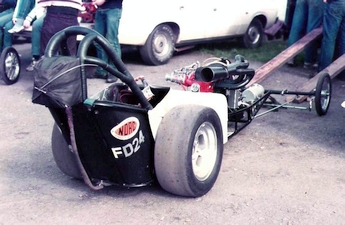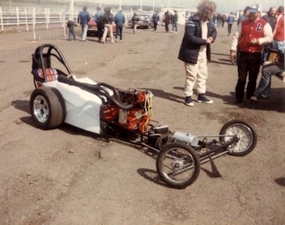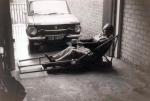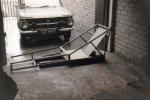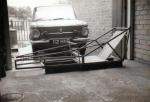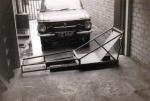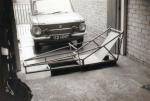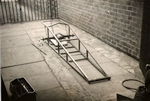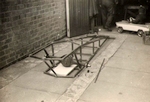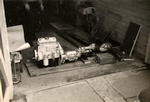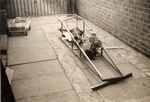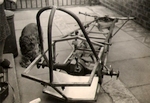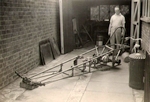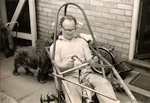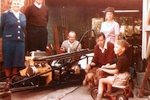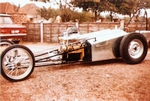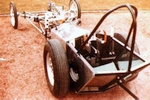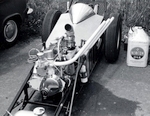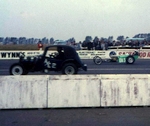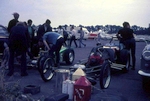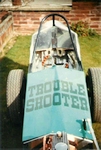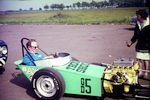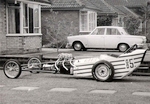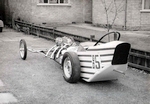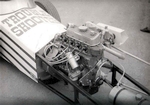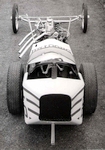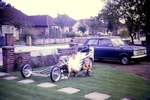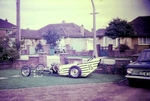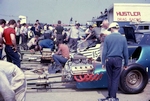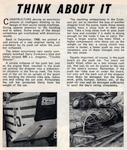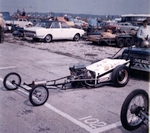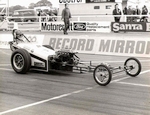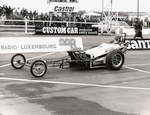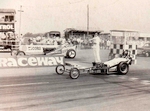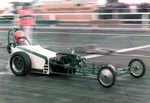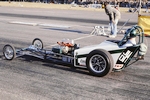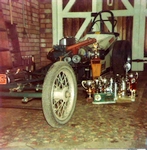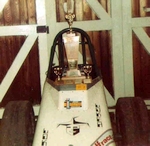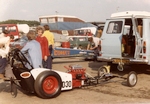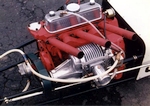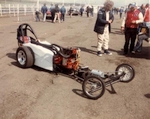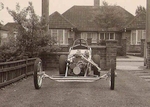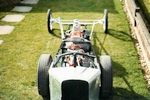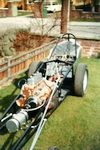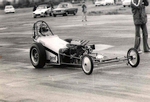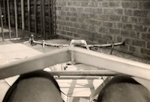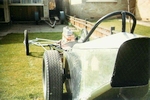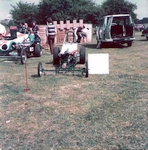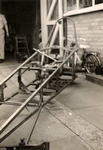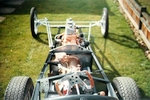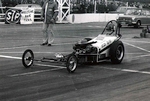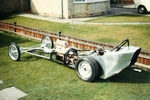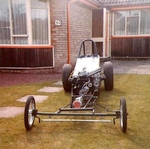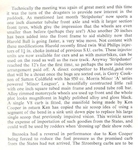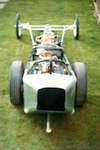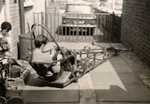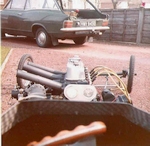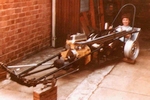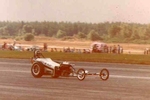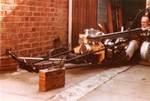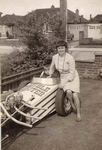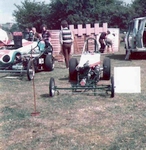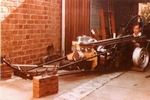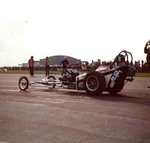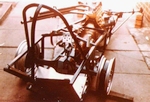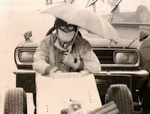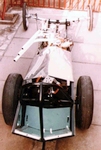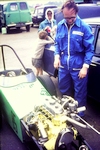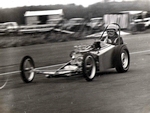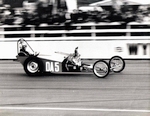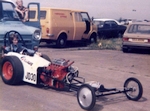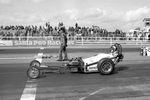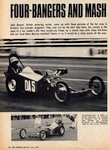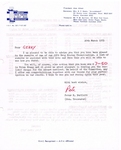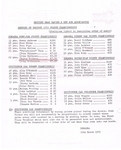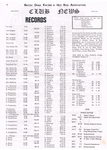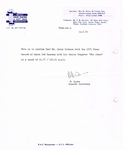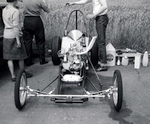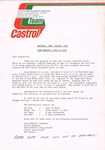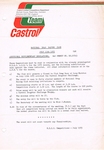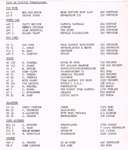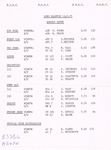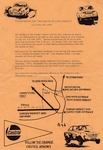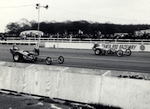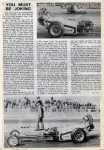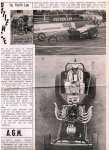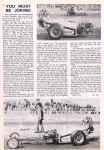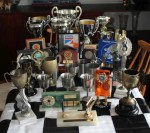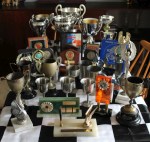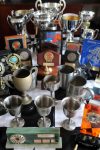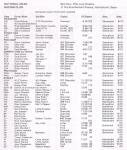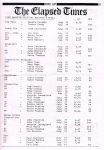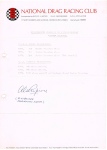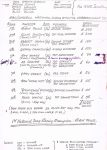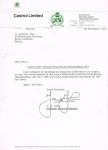
As told exclusively to Gerald Cookson had a mechanical and engineering career, during which he joined the Lucas Motor Club, read Hot Rod Magazine and built a Morris Minor engined slingshot 'Minor Leaguer' with the welding expertise of Ken Cooper. The dragster made its debut at Santa Pod in July 1966, with wife Joan and son Jerry helping out. A second dragster followed called 'Joker', which was upgraded, fitting injection, supercharger and stronger driveline components. Gerald ran the methanol-fuelled car to 1976 with recorded times in the low tens at 145mph. I was born in Aston, Birmingham at home, and am now 91. Early life was pretty easy, lived through WW2 as a child and went to school locally. When in senior school as they were then called, I sat several exams waiting to get into art college which I failed, then technical college which I managed to achieve. Although my father was in the building trade my career path was mechanical and engineering. I started an apprenticeship at a company who constructed cranes, hoists and winches. Then did my National Service, spending two years in Egypt in a channel zone. When I came back from there, I managed to get a job with Fisher and Ludlow Conveyor Systems. From there they decided they were going to move locally but way over in the Wolverhampton area. I didn’t fancy that so I got a job at Dunlop designing tyre factories for Eastern European countries. When that finished, I managed to join Lucas Electrical where I spent the rest of my working career until they were taken over by Magneti Marelli. I didn’t fancy the idea of traveling from home to Italy on a regular basis, so I took early redundancy and retirement. I then worked for myself doing factory planning for about three years and eventually retired in the mid to late 1980s. My wife Joan is from Weoley Castle and I was from Aston. We watched the house where we still live today being built and Jerry was born here. We’ve really enjoyed our time living here and did not want to move. As far as my Drag Racing career is concerned it was while I was at Lucas, I joined their Motor Club. I did one or two sprints, autocross and rallies with my wife's younger brother David. In that period, he started buying Hot Rod Magazine. I used to look at them, seeing these funny looking cars. He was a keen model maker building kits at the time, the early Revell and AMC kits which is where my son Jerry got his passion for model making from. This was at the time when Gerry Belton and Sydney Allard organized the 1964 Dragfests. David wanted to go to the Blackbushe and Chelveston events. I took Jerry to both but at Chelveston he nearly choked having a sweet in his mouth while running to see Tommy Ivo, swallowing the sweet giving us quite a scare for a bit. I was interested in motorsports and this looked like a motorsport that seemed accessible and affordable using small engines. I started off looking at building a motorcycle engined dragster, obviously chain drive, and basically a dragster version of the old Cooper Formula 3 cars, which had motorcycle engines driving the rear wheels but that soon changed as I got to like the front engined slingshot dragsters. I didn’t go the V8 route, thinking that was going to be too expensive for me and four bangers were plentiful so we went from there. Together we made a full-size wooden mock up model out of 1” square timber so we could see if it looked right which it did. We used a Morris Minor engine, single carburettor, gearbox, and back axle. It was during this period, and I don’t know how it came about, but I met up with Ken Cooper who lived about a mile or so away. We’d cut out the tubes and tacked them together. I was not proficient at welding so Ken Cooper kindly welded it all together, that was my first dragster.
It was called Minor Leaguer because of its Morris Minor origins. I constructed the whole car; it had the usual Ford Pop front axle which I split so that it was sort of a swing axle. I’d been looking through various motorsport magazines and there were some articles on rubber suspension. Rather than using the Ford Pop leaf spring, I managed to put a system together with rubber engine mounts in compression and that formed the front suspension. It worked pretty well and we had a lot of fun with it. This was in 1965 and our first meeting was in 1966 at Santa Pod July 31st for a meet organised by the British Hot Rod Association. The meet that had an unscheduled landing by a glider from the London Gliding Club at Dunstable.
It had polished aluminium body panels at the time, the green went on later and the engine was standard for our first event. Then I got hold of various tuning articles and did work on the cylinder head to improve that keeping the standard Morris gearbox and back axle which was narrowed, again with the help of Ken Cooper. If it hadn't been for Ken, I don’t know where we’d have been. The fuel system was the old vacuum windscreen wiper tank off a Ford Popular, fitted with a car tyre valve. You’d pressurize it with a foot pump and hoped you’d got enough pressure to get fuel to the carburettor.
Trouble Shooter at Santa Pod 1967 video... Click here That was in the days when we pushed started the dragsters. I can't remember which dragster it was; my wife was learning to drive at the time and we had a bit of an altercation on the fire up road. The push bar collapsed, jammed into the wooden push board on the front of the car and the whole thing went sideways, hit the barrier and crumpled the front of the chassis, it went onto its side.
Jerry says... This was Troubleshooter about 1969. There’s a photo of the bent bar in the back of Drag Racing & Hot Rod magazine.
It had a new front half put on it because I think it was still basically a square tube chassis and the back half was unscathed. It had a round tube front half from the engine forward grafted to it. After the accident Harold Bull quite generously gave me one of his front suspension units with the VW torsion bars inside. That was again welded on by Ken Cooper. All the cars we had ran on circuit race tyres because we couldn’t afford slicks which were quite expensive at that time. Everything was handmade including the body panels. We used that for quite some time; I can't remember how many years. It was then cut up and scrapped apart from the front end which was used on The Joker. The Joker had a completely new chassis and was my final dragster. I tack welded the new chassis which was then finished off by one of the contractors we used at Lucas. They were pipefitters doing all the pipe work within the factory.
It was at that point I had got my first supercharger and sort of copied Harold Bull’s fuel system. I built my own version of a Wall Phillips injector. The fuel system as you will know from Harold Bull was an oil pump driven from the camshaft pulley. That gave plenty of pressure for the Wall Phillips type injector. Again, the engine at that point was changed. I acquired a Cooper ‘S’ engine which had been modified to run inline. Somebody had cut the tapered clutch shaft off and welded an inline ‘A’ series drive spigot to the back of the crankshaft. It had a full race camshaft in there and that was my most successful dragster, running regular 10 second runs on methanol.
The rear axle was used from the previous cars but the gearbox was changed to a much stronger one from an MG Midget. The half shafts again were changed and I think somewhere along the line John Whitmore developed it by changing and grafting the insides of a Ford Anglia differential with the ring gear from an ‘A’ series so you could use Ford half shafts suitably shortened and the ends changed to give you a much stronger back axle. Much better than the ‘A’ series half shafts which were twisting badly. So, there was John Whitmore’s and Harold Bull’s influence in The Joker. At this point I acquired a Borg & Beck twin plate proper race clutch which helped a lot but again I was still using the current circuit race tyres, not being able to spend enough money for slicks. It spent a lot of time getting off the line but once it did it went well. The best time it ran was 10.1 seconds, the fastest terminal speed was about 145mph and that was at Snetterton uphill. It ran that speed 2 or 3 times but the actual time didn’t represent the terminal speed. The time was in the 11s but the terminal speed told you it should have run 9 seconds. I remember querying it several times with the NDRC time keepers. They got a bit upset because I was questioning their time keeping but I could not get my head around that. We had the rock-hard tyres which we referred to as ‘wooden tyres’.
Jerry adds... Back then we used bleach, whether that had any effect on them or not, it did have an effect on my Syd Mcdonald stripy trousers! Jerry recalls... The last season you ran the dragster was 1976. You did the ATV televised Castrol Dragster Challenge at Long Marston, which went out on TV the following Sunday with rallycross. Then it was a case of you wanting to do something different. Ray Feltell brought The Joker and ran it as Penetration.
Martin Jones and Steve Young had The Joker for a short while. Tony Brace has The Joker now and wants to put it back together, I still have quite a few of the original engine parts, as well as the supercharger. The original plans are laid flat under a mat in the house.
It was around the time when the class system was beginning to decline and it was around the start of bracket racing which was in its infancy. Everyone was umming and ahhing about it. Up until then I think most people were happy with the class system but there weren't enough cars in each class for a full elimination. You were getting 2 or 3 cars in a particular class. At this point I decided to go have a look at something else. Gallery: click on any thumbnail for a large image.
Back to pioneers index Back to News page |














































